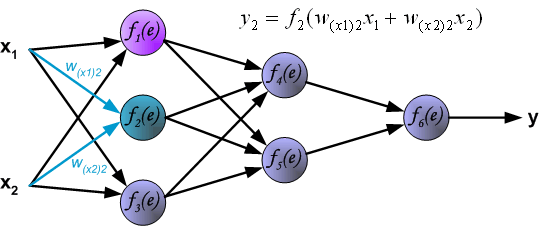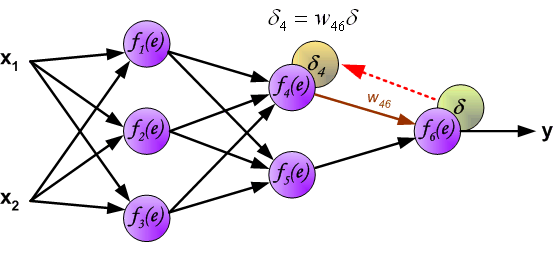反向传播(Back Propagation)与神经网络(Neural Network)
图片来自:http://galaxy.agh.edu.pl/~vlsi/AI/backp_t_en/backprop.html
程序实现参考:http://www.wildml.com/2015/09/implementing-a-neural-network-from-scratch/
实验数据来自于:http://yann.lecun.com/exdb/mnist/
感谢。侵删。
1.前向传播与反向传播
2.神经网路的实现
程序使用数据获取地址:https://raw.githubusercontent.com/lxrobot/lxrobot-s-code/master/data178x197.npy
#!/usr/bin/env python2 # -*- coding: utf-8 -*- """ Created on Thu Jul 19 19:11:28 2018 @author: rd """ from __future__ import division import numpy as np def sig(_z): _y=1/(1+np.exp(-_z)) return _y def predict(model,X): W1, b1, W2, b2 = model['W1'], model['b1'], model['W2'], model['b2'] z1 = X.dot(W1) + b1 #a1 = np.tanh(z1) a1=sig(z1) z2 = a1.dot(W2) + b2 exp_scores = np.exp(z2) probs = exp_scores / np.sum(exp_scores, axis=1, keepdims=True) return probs def get_accuracy(model,X,Y): probs=predict(model,X) pre_Y=np.argmax(probs,axis=1) comp=pre_Y==Y return len(np.flatnonzero(comp))/Y.shape[0] def get_loss(model,X,Y,reg_lambda): probs=predict(model,X) # Calculating the loss corect_logprobs = -np.log(probs[range(X.shape[0]), Y]) data_loss = np.sum(corect_logprobs) # Add regulatization term to loss data_loss += reg_lambda/2 * (np.sum(np.square(model['W1']))+ np.sum(np.square(model['W2']))) loss = 1./X.shape[0] * data_loss return loss def nn_model(X,Y,nn_hdim,nn_output_dim,steps,epsilon,reg_lambda): np.random.seed(0) W1 = np.random.randn(X.shape[1], nn_hdim) b1 = np.ones((1, nn_hdim)) W2 = np.random.randn(nn_hdim, nn_output_dim) b2 = np.ones((1, nn_output_dim)) model={} for i in xrange(steps): ###forward propagation Z1=np.dot(X,W1)+b1 #a1=np.tanh(Z1) a1=sig(Z1) Z2=np.dot(a1,W2)+b2 #softmax output exp_score=np.exp(Z2) prob = exp_score/np.sum(exp_score,axis=1,keepdims=1) #Backward Propagation delta3=prob delta3[range(X.shape[0]),Y]-=1 dW2 = np.dot(a1.T,delta3) delta2=np.dot(delta3,W2.T)*(1-np.power(a1,2)) dW1 = np.dot(X.T,delta2) #update the weight value dW2+=reg_lambda*W2 dW1+=reg_lambda*W1 W2+=-epsilon*dW2 W1+=-epsilon*dW1 if i%500==0: model = { 'W1': W1, 'b1': b1, 'W2': W2, 'b2': b2} print "The {} steps, Loss = {:2.5f}, Accaracy = {:2.5f}".format(i, get_loss(model,X,Y,reg_lambda), get_accuracy(model,X,Y)) return model def main(): """ The data is saved in a 57x197 numpy array with a random order, 197=14*14+1,14 is the image size, 1 is the label. """ datas=np.load('data178x197.npy') np.random.seed(14) np.random.shuffle(datas) sp=int(datas.shape[0]/3) train_X=datas[:sp,:-1] train_Y=datas[:sp,-1] test_X=datas[sp:,:-1] test_Y=datas[sp:,-1] reg_lambda=0.05 epsilon=0.01 steps=10000 nn_output_dim=2 nn_hdim=16 model=nn_model(train_X,train_Y,nn_hdim,nn_output_dim,steps,epsilon,reg_lambda) print"The test accuracy is {:2.5f}".format(get_accuracy(model,test_X,test_Y)) if __name__=='__main__': main() >>>python nn_model.py The 0 steps, Loss = 116.85237, Accaracy = 0.47458 The 500 steps, Loss = 7656.93264, Accaracy = 1.00000 The 1000 steps, Loss = 11102.96887, Accaracy = 1.00000 The 1500 steps, Loss = 14026.85439, Accaracy = 1.00000 The 2000 steps, Loss = 15287.36413, Accaracy = 1.00000 The 2500 steps, Loss = 16782.16622, Accaracy = 1.00000 The 3000 steps, Loss = 18721.08597, Accaracy = 1.00000 The 3500 steps, Loss = 19557.37682, Accaracy = 1.00000 The 4000 steps, Loss = 20139.67117, Accaracy = 1.00000 The 4500 steps, Loss = 21280.24345, Accaracy = 1.00000 The 5000 steps, Loss = 21331.53461, Accaracy = 1.00000 The 5500 steps, Loss = 22157.03441, Accaracy = 1.00000 The 6000 steps, Loss = 21961.40862, Accaracy = 1.00000 The 6500 steps, Loss = 22537.47486, Accaracy = 1.00000 The 7000 steps, Loss = 22923.17602, Accaracy = 1.00000 The 7500 steps, Loss = 23428.20322, Accaracy = 1.00000 The 8000 steps, Loss = 23646.00209, Accaracy = 1.00000 The 8500 steps, Loss = 23844.16144, Accaracy = 1.00000 The 9000 steps, Loss = 24419.29215, Accaracy = 1.00000 The 9500 steps, Loss = 23643.59117, Accaracy = 1.00000 The test accuracy is 0.99160
refer
[1] http://www.wildml.com/2015/09/implementing-a-neural-network-from-scratch/
[2] http://galaxy.agh.edu.pl/~vlsi/AI/backp_t_en/backprop.html
[3] http://yann.lecun.com/exdb/mnist/



















